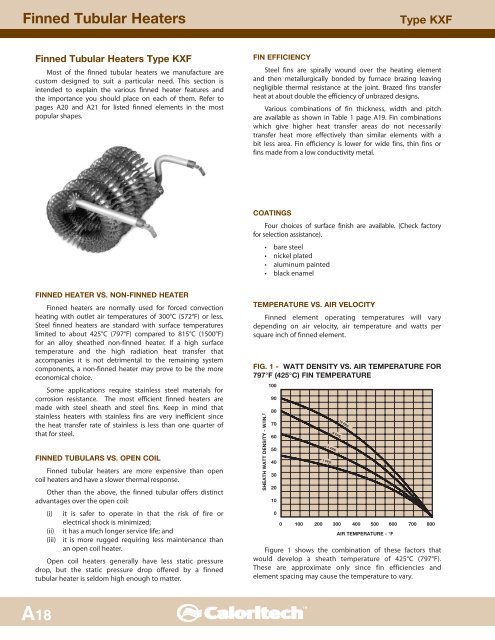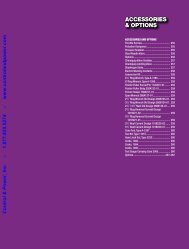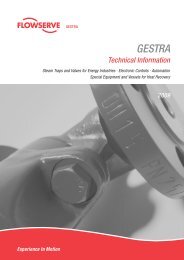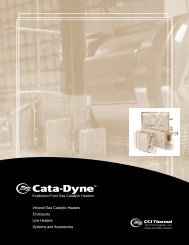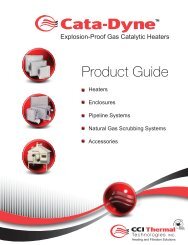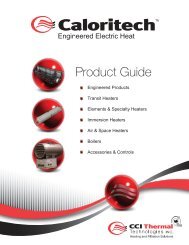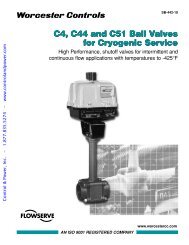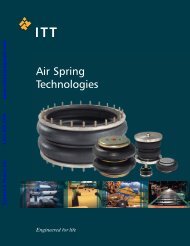Engineered Electric Heat - Control And Power
Engineered Electric Heat - Control And Power
Engineered Electric Heat - Control And Power
Create successful ePaper yourself
Turn your PDF publications into a flip-book with our unique Google optimized e-Paper software.
Finned Tubular <strong>Heat</strong>ers<br />
A1<br />
Finned Tubular <strong>Heat</strong>ers Type KXF<br />
Most of the finned tubular heaters we manufacture are<br />
custom designed to suit a particular need. This section is<br />
intended to explain the various finned heater features and<br />
the importance you should place on each of them. Refer to<br />
pages A20 and A21 for listed finned elements in the most<br />
popular shapes.<br />
FINNED HEATER VS. NON-FINNED HEATER<br />
Finned heaters are normally used for forced convection<br />
heating with outlet air temperatures of 300°C (572°F) or less.<br />
Steel finned heaters are standard with surface temperatures<br />
limited to about 425°C (797°F) compared to 815°C (1500°F)<br />
for an alloy sheathed non-finned heater. If a high surface<br />
temperature and the high radiation heat transfer that<br />
accompanies it is not detrimental to the remaining system<br />
components, a non-finned heater may prove to be the more<br />
economical choice.<br />
Some applications require stainless steel materials for<br />
corrosion resistance. The most efficient finned heaters are<br />
made with steel sheath and steel fins. Keep in mind that<br />
stainless heaters with stainless fins are very inefficient since<br />
the heat transfer rate of stainless is less than one quarter of<br />
that for steel.<br />
FINNED TUBULARS VS. OPEN COIL<br />
Finned tubular heaters are more expensive than open<br />
coil heaters and have a slower thermal response.<br />
Other than the above, the finned tubular offers distinct<br />
advantages over the open coil:<br />
(i) it is safer to operate in that the risk of fire or<br />
electrical shock is minimized;<br />
(ii) it has a much longer service life; and<br />
(iii) it is more rugged requiring less maintenance than<br />
an open coil heater.<br />
Open coil heaters generally have less static pressure<br />
drop, but the static pressure drop offered by a finned<br />
tubular heater is seldom high enough to matter.<br />
FIN EFFICIENCY<br />
Steel fins are spirally wound over the heating element<br />
and then metallurgically bonded by furnace brazing leaving<br />
negligible thermal resistance at the joint. Brazed fins transfer<br />
heat at about double the efficiency of unbrazed designs.<br />
Various combinations of fin thickness, width and pitch<br />
are available as shown in Table 1 page A19. Fin combinations<br />
which give higher heat transfer areas do not necessarily<br />
transfer heat more effectively than similar elements with a<br />
bit less area. Fin efficiency is lower for wide fins, thin fins or<br />
fins made from a low conductivity metal.<br />
COATINGS<br />
Four choices of surface finish are available. (Check factory<br />
for selection assistance).<br />
• bare steel<br />
• nickel plated<br />
• aluminum painted<br />
• black enamel<br />
TEMPERATURE VS. AIR VELOCITY<br />
Finned element operating temperatures will vary<br />
depending on air velocity, air temperature and watts per<br />
square inch of finned element.<br />
FIG. 1 - WATT DENSITY VS. AIR TEMPERATURE FOR<br />
797°F (425°C) FIN TEMPERATURE<br />
SHEATH WATT DENSITY - W/IN. 2<br />
100<br />
90<br />
80<br />
70<br />
60<br />
50<br />
40<br />
30<br />
20<br />
10<br />
Figure 1 shows the combination of these factors that<br />
would develop a sheath temperature of 425°C (797°F).<br />
These are approximate only since fin efficiencies and<br />
element spacing may cause the temperature to vary.<br />
<strong>Engineered</strong> <strong>Electric</strong> <strong>Heat</strong><br />
0<br />
1 FPS<br />
4 FPS<br />
9 FPS<br />
16 FPS<br />
0 100 200 300 400 500 600 700 800<br />
AIR TEMPERATURE - °F<br />
Type KXF


